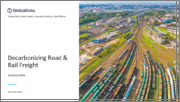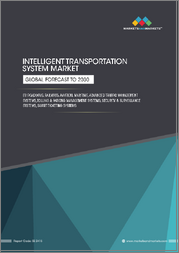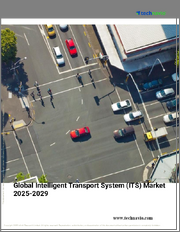
|
시장보고서
상품코드
1617542
도로 및 철도 화물 운송의 탈탄소화Decarbonizing Road & Rail Freight |
||||||
도로와 철도를 통한 화물 운송은 공급망을 움직이는 데 필수적이지만, IEA에 따르면 운송 부문은 2022년 전 세계 CO2 배출량의 23%를 차지할 것으로 예상됩니다. 넷제로 목표를 달성하기 위해서는 전기화, 대체연료, 수소 등 다양한 에너지 전환 기술을 도입해야 합니다. 본 보고서에서는 각 기술의 개발 단계와 도로 및 철도 화물 운송에 대한 적합성을 살펴봅니다.
2022년 교통 관련 배출량의 74%는 도로 운송이 차지했고, 대형 화물차는 16%, 철도는 1%입니다. IEA의 2050 NZE 시나리오에 맞추기 위해 교통 부문은 2030년까지 CO2 배출량을 연간 3% 이상 감축해야 합니다. 이 요구사항은 배출량 감축을 달성하기 위해 두 부문 모두 에너지 전환 기술을 결합하여 노력해야 한다는 것을 의미합니다.
도로 화물 운송은 트럭의 전기화에 초점을 맞추고 있지만, 주행거리 제한과 긴 연료 보급 시간 등의 문제는 업계 이해관계자들의 큰 관심사입니다. 수소를 연료로 사용하는 트럭은 장거리 주행과 빠른 연료 보급의 이점을 제공함으로써 이 부문의 탈탄소화에 중요한 역할을 할 것으로 예상됩니다. 그러나 높은 제조 비용과 연료 보급 인프라 부족은 여전히 보급에 걸림돌로 작용하고 있습니다. 한편, 대체 연료와 하이브리드 혼합 연료는 산업계가 수소 가격 하락과 대형 자동차 배터리의 성능 향상을 기대하는 동안 실행 가능한 임시 해결책이 될 수 있습니다.
도로 화물 운송과 달리 철도 화물 운송의 탈탄소화는 철도가 이미 청정 운송 수단이라는 인식 때문에 그다지 시급하게 다루어지지 않았습니다. 그러나 철도는 육상 장거리 벌크 운송에서 가장 효율적인 솔루션이기 때문에 화물 운송 산업의 탈탄소화에 필수적입니다.
최종적으로 배출량을 줄이고 순 제로 목표를 달성하기 위해서는 도로 부문과 철도 부문의 협력이 필수적입니다. 철도는 장거리 운송을 담당하고, 트럭은 주거 지역과 외딴 지역의 마지막 1마일 배송에 집중할 것입니다.
이 보고서는 전 세계 도로 및 철도 화물 운송 부문에 대한 조사 및 분석을 통해 이들 부문을 탈탄소화할 수 있는 전기화, 대체연료, 수소와 같은 에너지 전환 기술의 적합성을 평가합니다.
주요 하이라이트
- 효율성 향상 및 최적화 조치는 육상 화물 운송의 배출을 줄이는 가장 빠르고 비용 효율적인 방법입니다.
- 전동화는 기존의 ICE(내연기관)를 대체하여 철도 및 도로 화물 운송에 큰 탈탄소화 가능성을 가져다 줄 것입니다.
- FAME 바이오 디젤, HVO, 합성연료와 같은 대체 연료의 사용은 산업계가 수소와 같은 더 혁신적인 기술의 추가 개발을 기다리는 동안 배출 감소에 대한 잠정적인 솔루션을 제공합니다.
- 수소 연료전지와 수소 연소 엔진은 탄화수소 기반 연료를 수소로 대체함으로써 육상 화물 운송 산업에 큰 탈탄소화 잠재력을 제공합니다. 현재 이 기술의 보급은 전기 요금과 새로운 인프라의 높은 비용이 걸림돌로 작용하고 있습니다.
- 최종적으로 도로와 철도의 연계가 가장 큰 성과를 가져다 줄 것입니다. 앞으로 육상 운송은 복합 운송이 될 가능성이 높습니다. 철도는 장거리 운송에 적합하고 트럭은 처음 1km와 마지막 1km를 더 유연하게 커버할 수 있기 때문입니다.
목차
- 주요 요약
- 도로 및 철도 화물 운송 탄소 배출
- 에너지 전환 기술 소개
- 에너지 전환 기술 탈탄소화 가능성 평가
- 도로 및 철도 화물 운송 탈탄소화를 향한 주요 과제
- 도로 및 철도 화물 운송 넷제로 배출 목표
- 도로 및 철도 화물 운송 전기화
- 도로 및 철도 화물 운송의 대체 연료 : 바이오디젤과 합성연료
- 도로 및 철도 화물 운송의 수소
- 향후 방향성 : 부문 협력
Road and rail freight transport are essential to keep supply chains moving; however, they are significant sources of emissions. According to the IEA, in 2022, the transport sector accounted for 23% of global CO2 emissions in 2022. In order to meet net-zero targets, a range of energy transition technologies, including electrification, alternative fuels and hydrogen, will need be to be deployed. This report will tackle the development stage of each technology, as well as their suitability to road and rail freight.
In 2022, road transport accounted for 74% of all transport-related emissions, with heavy freight vehicles contributing 16% and rail only contributing 1% of all transport-related emissions. To align with the IEA's 2050 NZE scenario, the transport sector must reduce CO2 emissions by over 3% per year by 2030. Due to this requirement, both sectors will need to engage with a combination of energy transition technologies to achieve emissions reductions.
This report assesses the suitability of energy transition technologies such as electrification, alternative fuels, and hydrogen, which hold decarbonization potential for both sectors. This report also includes a snapshot of emissions targets and interim strategies from both sectors' biggest companies, as well as relevant governmental policies and initiatives.
In road freight, the emphasis is shifting toward the electrification of trucks, although challenges like limited range and lengthy refueling times are significant concerns for industry stakeholders. Hydrogen-fueled trucks are also expected to play a significant role in the sector's decarbonization, offering the benefits of longer journeys and faster refueling. However, their high production costs and a lack of refueling infrastructure continue to hinder widespread adoption. In the meantime, alternative fuels and hybrid blends present a viable interim solution while the industry anticipates price reductions for hydrogen and improved performance of batteries within heavy vehicles.
Unlike road freight, the decarbonization of rail freight has not been approached with the same urgency, largely due to the perception that rail is already a cleaner mode of transport. However, rail will be essential in decarbonizing the freight industry, as it represents the most efficient solution for long-haul bulk transport over land.
Ultimately, collaboration between the road and rail sectors will be crucial for reducing emissions and achieving net-zero targets. Intermodal transport will allow both sectors to leverage their strengths: trains will handle longer distances, while trucks will focus on last-mile deliveries in residential or remote areas.
Key Highlights
- Increasing efficiencies and optimization measures will represent the fastest and most cost-effective way to reduce emissions from land freight.
- Electrification will offer huge decarbonizing potential to both rail and road freight transportation as a substitute from traditional ICEs (internal combustion engines).
- The utilization of alternative fuels such as FAME biodiesel, HVO, and synthetic fuels will provide an interim solution for emission reductions whilst the industry awaits further development of more innovative technologies such as hydrogen.
- Hydrogen fuel cells and hydrogen combustion engines will offer great decarbonization potential for the land freight industry by replacing hydrocarbon-based fuels with the input of hydrogen. Widespread adoption of the technology is currently hindered by the high costs of both electricity and new infrastructure.
- Ultimately, collaboration between road and rail will yield the biggest results. Going forward, land freight is likely to be intermodal, i.e.: a combination of both modes of transport, as trains are better suited for long-haul, and trucks are able to cover the first and last kilometres with better flexibility.
Scope
- Global CO2 emissions from the road and rail freight industry, relevant policies for the decarbonization of the industry, analysis of strategies adopted by major players in the road and rail freight industry - including case studies, analysis of different decarbonizing technologies such as electrification, adoption of alternative fuels, and hydrogen.
Reasons to Buy
- Identify market trends within the industry and assess who the biggest players in land freight are and what they are doing to reduce emissions.
- Develop market insight of the major technologies used to decarbonize land freight through case studies from industry leaders in both road and rail.
- Understand adoption trends of emerging low-carbon technologies such as hydrogen fuel cell vehicles and hydrogen-powered rail.
Table of Contents
Table of Contents
- Executive summary
- Road and rail freight carbon emissions
- Introduction to energy transition technologies
- Assessing the decarbonization potential of energy transition technologies
- Main challenges to decarbonizing road and rail freight
- Road and rail freight net-zero emission targets
- Electrifying road and rail freight
- Alternative fuels in road and rail freight: biodiesel and synthetic fuels
- Hydrogen in road and rail freight
- The way forward: sector cooperation



















